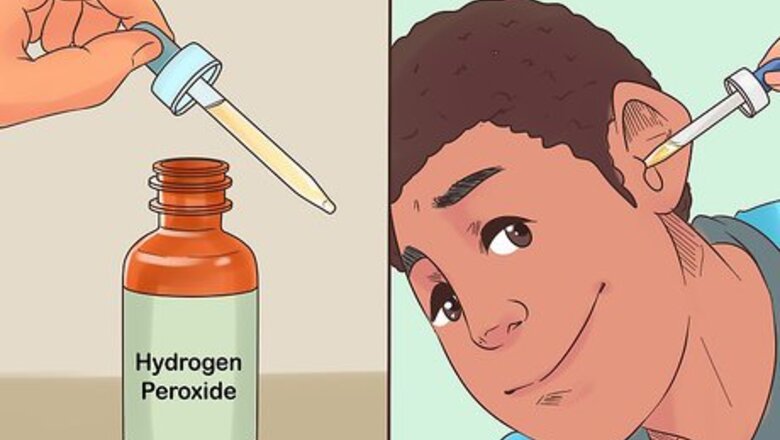
views
Drying Out Ears
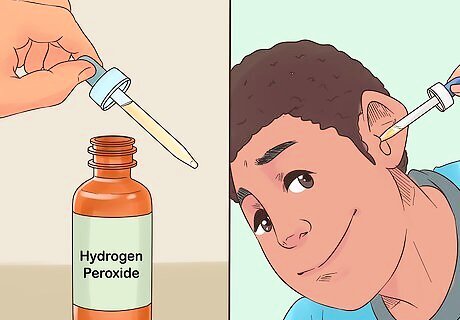
Clean your ears out with hydrogen peroxide. Fill half of an ear dropper with hydrogen peroxide. Turn your head so that the affected ear is on top. Drop the hydrogen peroxide into the ear. Once the crackling noise stops (usually within 5 minutes), tilt your head so that your affected ear faces down. Tug on the earlobe to help the ear drain. Tip: Hydrogen peroxide can help the fluids evaporate while cleaning out any ear wax that could be trapping the fluids.
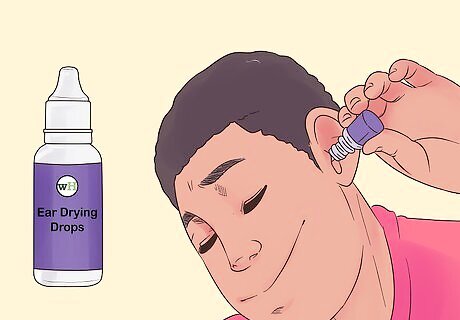
Apply ear drying drops to your ears. You can buy these over-the-counter at pharmacies and grocery stores. The solution will usually come with an ear dropper, but they are typically available for purchase at pharmacies if not. Alternatively, you can make your own drying drops with equal parts white vinegar and isopropyl alcohol. How to Use Ear Drops Get them to room temperature: Ear drops that are too hot or too cold can lead to dizziness. Put your ear drops in your pants pocket for 30 minutes and walk around to get them to the right temperature. Read the instructions: Always look over the instructions on the package, including any side effects that may occur. Check the expiration date: Never use drops that are expired. Ask a friend to help: It’s difficult to put ear drops in your own ear, so ask someone to help you. For adults and teens: Lay your head on a towel with your affected ear facing up. Have your friend gently pull your earlobe up and out, and then administer the correct number of drops into the ear canal. Push on the ear flap to send the liquid into the ear, and then wait for 1-2 minutes. For children: Have the child lay their head on a towel with their affected ear facing up. Gently pull the child’s earlobe out and down to straighten the auditory tube, and administer the right amount of drops. Push on the flap of the ear and wait for 2-3 minutes. If you have fluid in both ears: Wait about five minutes or plug the first ear with a cotton ball before starting on the second ear.
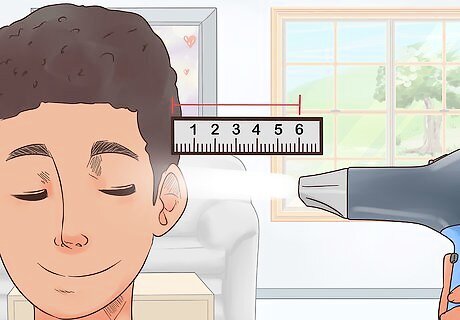
Blow your ear with a hairdryer. Turn the hairdryer onto its lowest heat and fan setting. Set the blow-dryer about 6 inches (15 cm) from your ear. Let the cool air blow into your ear. The air can help dry up some of the fluid that is caught in the ear.

Dry your outer ears with a towel after swimming and showering. Don’t put the towel inside of your ear. Just wipe off the water on the outside to prevent more fluid from building up in your ears.
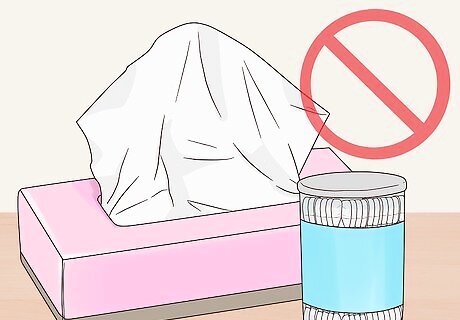
Avoid using cotton swabs or tissues in your ears. These can irritate and scratch your ears, increasing your chances of getting an infection. Instead, if you can’t dislodge the water on your own, see a doctor for help.
Dislodging Fluid

Tug the outside of your ear while tilting your head. Point your affected ear down to the ground. Tug on your earlobe and the outer cartilage in different directions to open up your ear. You may feel the fluid drain out. Repeat if needed on the other ear. This is a good way to get rid of water after swimming or a shower.
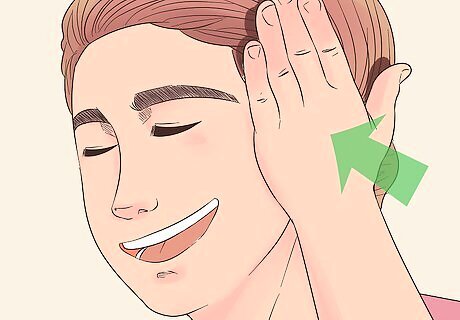
Create a vacuum with your hand to release the fluid. Place the palm of your hand tightly over your ear. Press down a few times before removing your hand. Tilt your ear down so that the water can drain out.
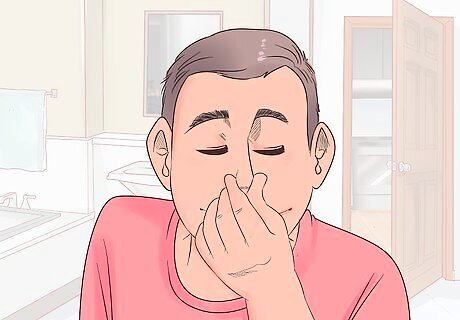
Relieve the pressure with a gentle Valsalva maneuver. Take a breath and hold it. Plug your nose with 2 fingers, and force air up the Eustachian tubes in your ears by blowing. You should feel a pop if it works. Tilt your head downward, with the affected ear facing toward the ground to let the fluid drain out. Do not do this if you think you have an ear infection. Be gentle as you blow. If you blow too hard, you may cause a nosebleed.
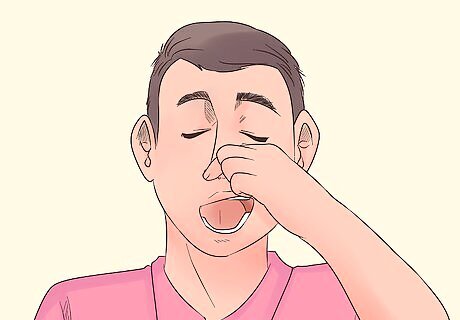
Pinch your nose and yawn to force the fluid down your throat. Hold your nostrils closed with your fingers. Take a few deep yawns in a row. This may cause the fluid to slide back down your throat, removing it from your ears.

Lie down with your affected ear turned downward. Rest on your side, with the affected ear down against a towel, pillow, or cloth. After a few minutes, the ear may start to drain. You can even take a nap or try this overnight as you sleep.
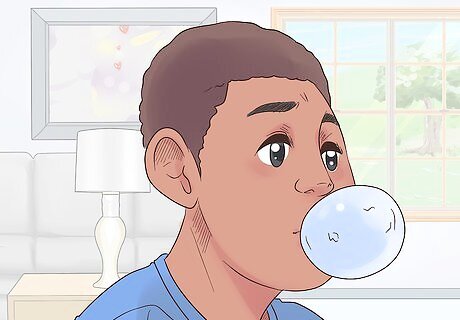
Chew on gum or food. Chewing often opens up the Eustachian tubes. Tilt your head as you chew to encourage fluid to drain from your ears. If you don’t have any gum or food on you, try just pretending to chew. You can also try sucking on a hard candy to get the same effect.
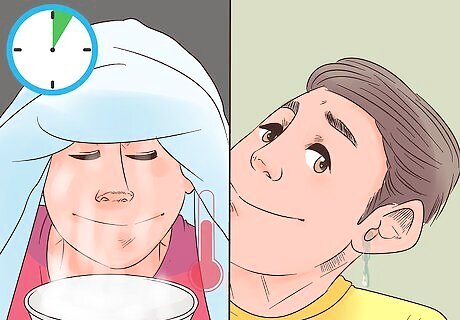
Loosen the fluid with steam treatment. Sometimes, a long, hot shower is enough to loosen the fluid in your ear. However, if not, a simple steam treatment may thin the fluid, making it easier to drain. Pour hot water into a bowl. Lean over the bowl and drape a towel over your head. Inhale the steam for 5-10 minutes. Then tilt your affected ear to the side to let the fluid drain out. At-Home Steam TreatmentFill a bowl with hot, steaming water. Add a few drops of anti-inflammatory oils, like chamomile or tea tree, if desired. Drape a towel over your head and lean over the bowl, inhaling the steam for 5-10 minutes. Then, tilt your affected ear to the side and let the fluid drain out into the bowl.Be careful: Always exercise caution with steam, as it can get very hot. Try placing your hand over the steam to see if it's a comfortable temperature before putting your face near it.
Treating Medical Causes
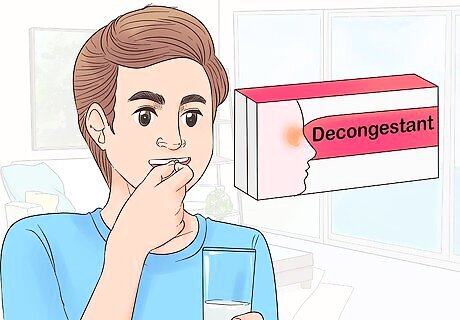
Take a decongestant if you have a sinus infection or cold. The decongestant will allow your ears to drain naturally. Take the medication according to the instructions on the label. You can use an over-the-counter decongestant, such as Sudafed or Afrin, in pill or spray form. Decongestants: Not for EveryoneUnfortunately, decongestants aren’t safe for certain groups of people. If you or a loved one falls into one of these categories and is in need of a decongestant, consult with a doctor before moving forward.Pregnant and breastfeeding women: For many decongestants, there is no established risk for pregnant/breastfeeding women with short-term use. However, not all decongestants are created equal. Ask your doctor about the decongestant that is right for you.People taking other medications: It’s always possible that a decongestant will interact with another medication in a harmful way.Diabetics: Decongestants tend to lead to increases in blood sugar.People with high blood pressure: Decongestants work by narrowing blood vessels and reducing swelling in the nose, but this can affect other blood vessels and lead to a spike in blood pressure. Opt for a cold medication that is designed for people who have high blood pressure instead.People with hypo or hyperthyroidism: Pseudoephedrine, the active ingredient in many common decongestants, can worsen many symptoms of both hypo and hyperthyroidism.People with glaucoma: Decongestants generally have little effect on open-angle glaucoma, which is more common. People with closed-angle glaucoma, however, should exercise caution, because decongestants can lead to pupil dilation and angle closure.
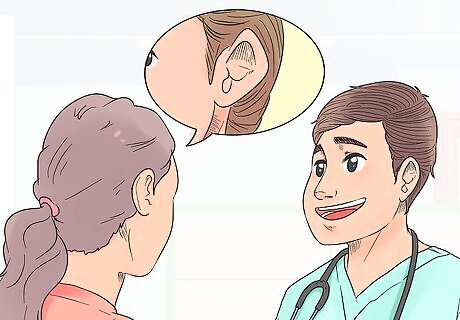
Visit your doctor if your ears don’t clear up after 3-4 days. Your doctor may prescribe a cortisone pill, such as Prednisone or Medrol. Take this medication according to your doctor’s instructions. Your ears will usually clear up after 3-4 days. This pill will decrease inflammation in your Eustachian Tubes in your ears so that fluid can drain naturally.
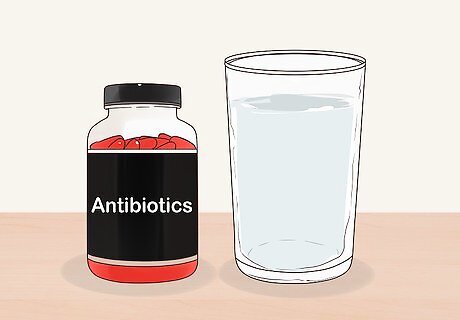
Take antibiotics as prescribed by your doctor. Antibiotics are especially important for children, although adults may use them too. The antibiotics will treat any current infection and prevent new ones from developing.

Have a doctor check for growths if fluid appears in 1 ear without a cold. If you suddenly have unexplained fluid in only 1 of your ears, it can be a symptom of a growth, such as a benign tumor or cancer. Ask your doctor for a referral to an Ear, Nose, and Throat (ENT) doctor.The ENT will perform a cancer screening. The ENT will begin with a visual examination of your ear and blood tests. If they think you have a growth in your ear, they will give you a local anesthetic and take a sample of the tissue for testing. MRI scans may also be used.
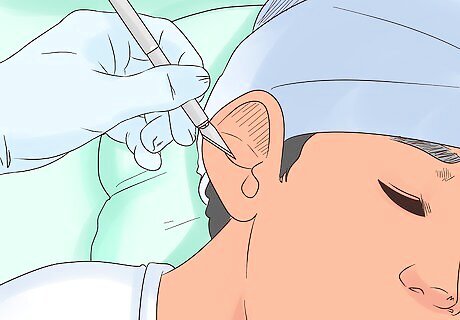
Opt for surgery if the fluid can't be removed any other way. Since it can take a while for the ear to drain completely, they may place a tube in your ear. When your ears have healed, your doctor will remove the tube at their office. They will also follow up with you occasionally to make sure your ears are in good condition after the surgery. Children may need the tubes in their ears for between 4 and 6 months. Adults may only need the tubes for 4-6 weeks. The first surgery will require anesthesia at a hospital as an outpatient procedure. Tubes often fall out on their own, or they can be removed without the use of anesthesia at your doctor's office.


















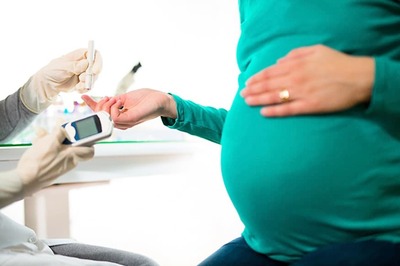

Comments
0 comment